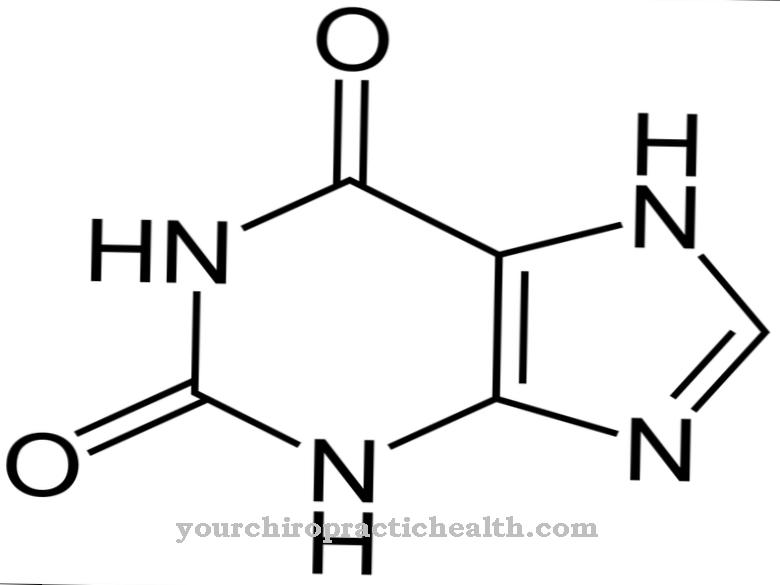Fluoroapatite occurs naturally in the form of crystals. In the human body, it is mainly found in the teeth and bones.
The inorganic crystalline compound makes the tooth enamel more resistant to acids and can thus prevent the development of caries. If there is enough fluorapatite in the bones, the risk of developing osteoporosis in old age is lower.
What is fluoroapatite?
Naturally occurring fluoroapatite is a mineral that belongs to the class of phosphates, arsenates and vanadates (anhydrous phosphates with foreign anions). If you treat it with UV light or heat it, it starts to glow. It is also soluble in nitric and hydrochloric acid.
The molecular formula of fluoroapatite is Ca5 (PO4) 3F. In the human body it is found in the osteoclasts of the bones and in the dentin and enamel. The higher its fluorapatite content, the more resistant the enamel is to acids. Fluorapatite, on the other hand, is more resistant than hydroxyapatite, which is also found in tooth enamel. This property is used in caries prophylaxis. About 90 percent of the fluoride in the human body is in the bones. Around 2.5 percent of this is fluoroapatite.
Function, effect & tasks
Fluorapatite makes tooth enamel more resistant to acids. They are formed by bacteria or ingested through daily food. The harmful compounds loosen minerals from the tooth enamel and sometimes even from the dentine underneath, so that holes (caries) develop.
The formation of fluorapatite with the help of tooth fluoridation can effectively prevent tooth decay. In the case of existing caries, it remineralises the damaged teeth. Since the daily food intake does not contain sufficient fluoride - experts estimate the fluoride content in it to be 0.2 to 0.5 mg - the user should take more fluoride every day if he wants to prevent tooth decay. Daily use of fluoride toothpaste and mouth rinse is suitable for this. Once a week he should apply a fluoride-containing dental gel. The treatment of the enamel with varnish containing fluoride takes place exclusively in the dental practice. It is important that the user does not exceed the maximum daily dose. It is 0.05 mg per kilogram of body weight per day (adults) and 0.1 mg / kg body weight per day for children.
The German Society for Dentistry, Oral and Maxillofacial Medicine (DGZMK) recommends that small children brush their teeth with a small amount of children's toothpaste once a day after they have erupted their teeth. It has a lower fluoride content than adult toothpaste. From the age of 2, teeth should be brushed with it twice a day. From school entry, the child can then use normal fluoride toothpaste. The additional use of fluoride gels, solutions and varnishes is only necessary if there is an increased risk of caries.
Fluoride tablets should only be given to older children and then only sucked.The latest research shows that toothpastes containing hydroxyl are even more effective than fluoride toothpaste: the fluoride only forms fluorapatite on the surface of the tooth, while the hydroxyapatite even remineralizes the bottom of cavities.
Education, occurrence, properties & optimal values
Fluorapatite is formed when the tooth enamel is treated with substances containing fluoride. The supplied fluorine ions replace the OH group of the hydroxyapatite. The most resistant mineral found in tooth enamel is the fluoride fluorapatite.
It forms an extremely thin protective layer on the tooth surface, but has to be rebuilt every day for life in order to be able to protect the tooth sufficiently. Since fluorapatite is only produced by the external treatment of the tooth with agents containing fluoride (fluoridation), dentists recommend that this substance be administered locally on a daily basis. This can be done, for example, by sucking fluoride tablets and using toothpaste containing fluoride.
Diseases & Disorders
As long as the maximum daily dose is not exceeded when using fluoride-containing agents, there is no risk to the health of the user. With only topical application, the risk of accidental overdose is lower than with systemic use (swallowing the preparation).
Excessive doses of fluoride can lead to dental fluorosis (overcalcification of the tooth enamel) in children. It is clearly recognizable by permanent, brownish discolored areas on the teeth. Dental fluorosis is harmless, but because of its unsightly appearance, it can be a psychological strain on child patients. It should also be seen as an indication that the rest of the body may have been damaged by the excessive fluoride intake. Since fluoride compounds are slightly toxic, irreversible damage can occur, especially in the event of prolonged overdosing. For example, excessively high concentrations in children can impair their cognitive abilities. It can also cause permanent damage to the kidneys, glands, brain and bones.
In fluorosis, the bones are so hardened that they become brittle even with minor injuries. In addition, the spine, bones and joints stiffen. Excessive fluoride doses can lead to thyroid and nerve damage, reduced fertility in men, type 2 diabetes and vasoconstriction (proven in animal experiments). In the case of acute fluoride poisoning, the patient should consult his doctor immediately, as the substance forms the highly toxic hydrogen fluoride in the stomach. It attacks the stomach and intestinal lining.
Symptoms of such poisoning are abdominal pain, nausea, and vomiting. The systemic supply of fluoride via table salt containing fluoride and foods containing fluoride causes the bone substance to become harder (osteoporosis prophylaxis). The fluoride is absorbed in the small intestine and taken up into the bloodstream.




.jpg)



















.jpg)



